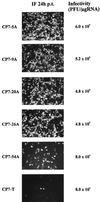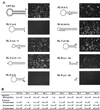Mutations in the 5' nontranslated region of bovine viral diarrhea virus result in altered growth characteristics - PubMed (original) (raw)
Mutations in the 5' nontranslated region of bovine viral diarrhea virus result in altered growth characteristics
P Becher et al. J Virol. 2000 Sep.
Abstract
The 5' nontranslated region (NTR) of pestiviruses functions as an internal ribosome entry site (IRES) that mediates cap-independent translation of the viral polyprotein and probably contains additional cis-acting RNA signals involved in crucial processes of the viral life cycle. Computer modeling suggests that the 5'-terminal 75 nucleotides preceding the IRES element form two stable hairpins, Ia and Ib. Spontaneous and engineered mutations located in the genomic region comprising Ia and Ib were characterized by using infectious cDNA clones of bovine viral diarrhea virus. Spontaneous 5' NTR mutations carrying between 9 and 26 A residues within the loop region of Ib had no detectable influence on specific infectivity and virus growth properties. After tissue culture passages, multiple insertions and deletions of A residues occurred rapidly. In contrast, an engineered mutant carrying 5 A residues within the Ib loop was genetically stable during 10 tissue culture passages. This virus was used as starting material to generate a number of additional mutants. The analyses show that (i) deletion of the entire Ib loop region resulted in almost complete loss of infectivity that was rapidly restored during passages in cell culture by insertions of variable numbers of A residues; (ii) mutations within the 5'-terminal 4 nucleotides of the genomic RNA severely impaired virus replication; passaging of the supernatants obtained after transfection resulted in the emergence of efficiently replicating mutants that had regained the conserved 5'-terminal sequence; (iii) provided the conserved sequence motif 5'-GUAU was retained at the 5' end of the genomic RNA, substitutions and deletions of various parts of hairpin Ia or deletion of all of Ia and part of Ib were found to support replication, but to a lower degree than the parent virus. Restriction of specific infectivity and virus growth of the 5' NTR mutants correlated with reduced amounts of accumulated viral RNAs.
Figures
FIG. 1
5′ sequences of pestiviruses, in particular BVDV-1 strain CP7. (A) Alignment of the 5′-terminal sequences of representative strains from four pestivirus species. For BVDV-1 CP7, the consensus sequence was determined from 10 cDNA clones. Other sequences were extracted from the GenBank/EMBL database (BVDV-1 Osloss [15], BVDV-1 NADL [12], classical swine fever virus [CSFV] Alfort-T [28], CSFV Brescia [31], border disease virus [BDV] X818 [4], BVDV-2 890 [36]). Conserved nucleotides are indicated with an asterisk. The region of the CP7 5′ sequence shown in panel B is marked by a line above the alignment; the region with the variable numbers of A residues is marked by arrows. (B) Nucleotide sequences of three CP7 5′ clones carrying either 9, 20 or 26 A residues following position 44 of the CP7 sequence. The numbers on top correspond to those of the CP7 sequence shown in panel A. (C) Nucleotide sequences of 10 CP7 clones. The clones shown in panel B are included. Note the variable number of A residues following position 44. (D) Predicted RNA secondary structure of the 5′ NTR of BVDV-1 CP7-9A. Modeling was performed with the computer programs RNAFOLD, MFOLD, and FOLDANALYZE (17). In addition, the proposed structure is based on comparative sequence analysis. Nt 362 to 389 were excluded from secondary-structure interactions because this region contributes to a putative pseudoknot structure. The BVDV 5′ NTR stem-loops are designated according to the nomenclature proposed by Brown et al. (9). The initiation codon AUG is indicated.
FIG. 2
Multiple insertions and deletions of A residues downstream of position 44 during propagation of BVDV 5′ NTR mutants in bovine cells. After transfection with engineered full-length RNAs, the recovered BVDV mutants CP7-9A, CP7-20A, CP7-26A, CP7-54A, and CP7-5A were repeatedly passaged in MDBK cells. After 10 passages, the 5′ NTR sequences and the numbers of A residues following position 44 were determined for each mutant by sequence analysis of 12 cDNA clones. Each value represents one clone, except for CP7-5A, for which all 12 clones gave the same value. The boxed numbers of A residues were introduced into the infectious CP7 full-length cDNA clone.
FIG. 3
IF analysis of MDBK cells at 24 h p.t. with engineered full-length RNAs from CP7-5A, CP7-9A, CP7-20A, CP7-26A, CP7-54A, and CP7-T. Magnification, ×100. The specific infectivities of the BVDV CP7 mutant RNAs are indicated.
FIG. 4
Virus titers obtained for BVDV 5′ NTR mutants CP7-5A, CP7-9A, CP7-20A, CP7-26A, CP7-54A, and CP7-T at 24, 48, and 72 h p.t. The titers of released virus were determined on MDBK cells.
FIG. 5
Hairpin Ia mutants. (A) Computer-predicted RNA secondary structures of BVDV hairpin Ia mutations and IF analysis of MDBK cells at 24 h p.t. with full-length RNAs from CP7-5A, SL-1, SL-2, SL-3, SL-4, SL-5, SL-6, SL-7, SL-8, and SL-9. Magnification, ×100. Modeling was performed with the computer programs RNAFOLD and MFOLD (17). Deleted (Δ) and substituted nucleotides within hairpin Ia are indicated. (B) Specific infectivities of the BVDV mutant RNAs in MDBK cells and virus titers obtained at 24, 48, and 72 h p.t.
FIG. 6
Deletion of hairpins Ia and Ib. (A) Schematic representation of the 5′ NTR of BVDV CP7-5A and deletion mutants Δ2-31, Δ5-57, and Δ5-73. (B) IF analysis of MDBK cells at 24 h p.t. Magnification, ×100. (C) Specific infectivities in MDBK cells and virus titers obtained at 24, 48, and 72 h p.t. (D) 5′-terminal sequences of CP7-5A, Δ5-73, and mutant viruses M1 and M2 evolved after passaging of supernatants from cells transfected with Δ5-73 RNA. For M1 and M2, the inserted nucleotides are highlighted.
FIG. 7
Plaques produced by BVDV 5′ NTR mutants at day 6 p.t. (A) Plaque size of CP7-5A, SL-2, SL-3, SL-5, SL-6, SL-7, SL-8, Δ2-31, and Δ5-57 in MDBK cells. The average plaque size of 20 randomly selected plaques is indicated. (B) As examples, the plaques generated by CP7-5A, SL-7, and SL-8 are shown.
FIG. 8
(A) Growth curves of BVDV CP7-5A and mutant BVDV strains SL-2, SL-3, SL-5, SL-6, SL-7, Δ2-31, and Δ5-57 determined on MDBK cells infected at an MOI of 0.05. The titers of released virus were determined over a 4-day period. (B) Northern blot analysis of total RNA from MDBK cells infected with BVDV CP7-5A and the indicated mutant BVDV strains at an MOI of 0.05. The infected cells were processed in parallel to those used to determine the growth rates. RNAs were extracted at 48 h after infection. The blot was hybridized with a BVDV CP7-specific cDNA fragment. RNA ladder sizes are indicated on the left (in kilobases). The intensity of bands was determined with a phosphorimager. The relative amounts of viral genomic RNAs are indicated below the blot (percent of parent CP7-5A [100%] value). n.i., RNA from noninfected MDBK cells.
Similar articles
- cis-acting RNA elements required for replication of bovine viral diarrhea virus-hepatitis C virus 5' nontranslated region chimeras.
Frolov I, McBride MS, Rice CM. Frolov I, et al. RNA. 1998 Nov;4(11):1418-35. doi: 10.1017/s1355838298981031. RNA. 1998. PMID: 9814762 Free PMC article. - A stem-loop motif formed by the immediate 5' terminus of the bovine viral diarrhea virus genome modulates translation as well as replication of the viral RNA.
Yu H, Isken O, Grassmann CW, Behrens SE. Yu H, et al. J Virol. 2000 Jul;74(13):5825-35. doi: 10.1128/jvi.74.13.5825-5835.2000. J Virol. 2000. PMID: 10846062 Free PMC article. - Essential and nonessential elements in the 3' nontranslated region of Bovine viral diarrhea virus.
Pankraz A, Thiel HJ, Becher P. Pankraz A, et al. J Virol. 2005 Jul;79(14):9119-27. doi: 10.1128/JVI.79.14.9119-9127.2005. J Virol. 2005. PMID: 15994806 Free PMC article. - Genetic analysis of the internal ribosome entry segment of bovine viral diarrhea virus.
Chon SK, Perez DR, Donis RO. Chon SK, et al. Virology. 1998 Nov 25;251(2):370-82. doi: 10.1006/viro.1998.9425. Virology. 1998. PMID: 9837801 - RNA recombination in pestiviruses: cellular RNA sequences in viral genomes highlight the role of host factors for viral persistence and lethal disease.
Becher P, Tautz N. Becher P, et al. RNA Biol. 2011 Mar-Apr;8(2):216-24. doi: 10.4161/rna.8.2.14514. Epub 2011 Mar 1. RNA Biol. 2011. PMID: 21358277 Review.
Cited by
- Molecular Characteristics of Bovine Viral Diarrhea Virus Strains Isolated from Persistently Infected Cattle.
Wu Y, Zhang G, Jiang H, Xin T, Jia L, Zhang Y, Yang Y, Qin T, Xu C, Cao J, Ameni G, Ahmad A, Ding J, Li L, Ma Y, Fan X. Wu Y, et al. Vet Sci. 2023 Jun 25;10(7):413. doi: 10.3390/vetsci10070413. Vet Sci. 2023. PMID: 37505819 Free PMC article. - Increased genetic variation of bovine viral diarrhea virus in dairy cattle in Poland.
Mirosław P, Polak M. Mirosław P, et al. BMC Vet Res. 2019 Aug 5;15(1):278. doi: 10.1186/s12917-019-2029-z. BMC Vet Res. 2019. PMID: 31382966 Free PMC article. - Nonreplicative RNA Recombination of an Animal Plus-Strand RNA Virus in the Absence of Efficient Translation of Viral Proteins.
Kleine Büning M, Meyer D, Austermann-Busch S, Roman-Sosa G, Rümenapf T, Becher P. Kleine Büning M, et al. Genome Biol Evol. 2017 Apr 1;9(4):817-829. doi: 10.1093/gbe/evx046. Genome Biol Evol. 2017. PMID: 28338950 Free PMC article. - Use of homologous recombination in yeast to create chimeric bovine viral diarrhea virus cDNA clones.
Arenhart S, Silva JV Junior, Flores EF, Weiblen R, Gil LH. Arenhart S, et al. Braz J Microbiol. 2016 Oct-Dec;47(4):993-999. doi: 10.1016/j.bjm.2016.07.022. Epub 2016 Jul 26. Braz J Microbiol. 2016. PMID: 27522929 Free PMC article. - Complete genome sequence of a novel pestivirus from sheep.
Becher P, Schmeiser S, Oguzoglu TC, Postel A. Becher P, et al. J Virol. 2012 Oct;86(20):11412. doi: 10.1128/JVI.01994-12. J Virol. 2012. PMID: 22997427 Free PMC article.
References
- Becher P, Orlich M, Kosmidou A, König M, Baroth M, Thiel H-J. Genetic diversity of pestiviruses: identification of novel groups and implications for classification. Virology. 1999;262:64–71. - PubMed
- Becher P, Orlich M, Shannon A D, Horner G, König M, Thiel H-J. Phylogenetic analysis of pestiviruses from domestic and wild ruminants. J Gen Virol. 1997;78:1357–1366. - PubMed
- Becher P, Shannon A D, Tautz N, Thiel H-J. Molecular characterization of border disease virus, a pestivirus from sheep. Virology. 1994;198:542–551. - PubMed
Publication types
MeSH terms
Substances
LinkOut - more resources
Full Text Sources
Other Literature Sources
Miscellaneous







